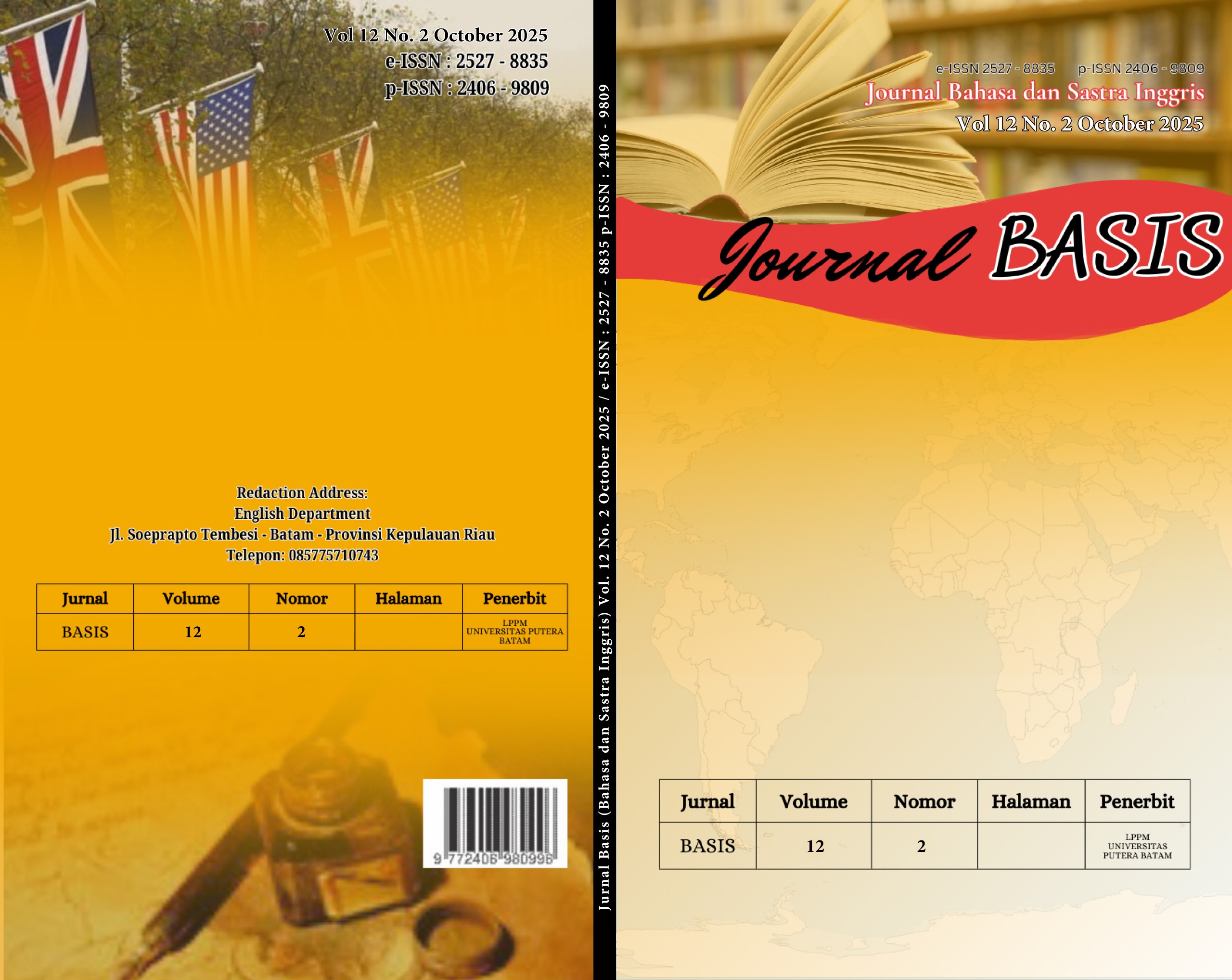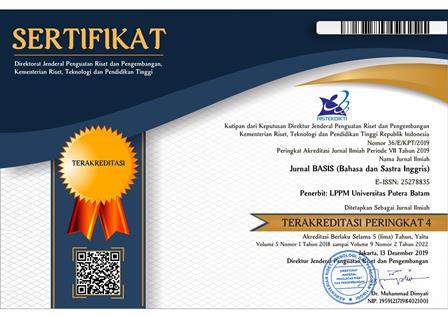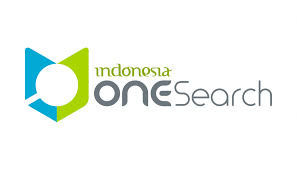ENGLISH LANGUAGE LEARNING FROM STUDENTS' PERSPECTIVE: THE ABSENCE OF DIGITAL MEDIA AS A BARRIER TO TEACHING QUALITY
DOI:
https://doi.org/10.33884/basisupb.v12i2.10802Keywords:
Students’ Perspective, Teaching Quality, Digital Media, Quantitative Research, English Language Learning.Abstract
The integration of digital media in English language teaching (ELT) has been widely recognized for improving students’ motivation, engagement, and learning outcomes. However, few studies have examined how students perceive the absence of such media in their classrooms. This study investigated the perceptions of eighth-grade students at SMPN 13 Surabaya regarding the lack of digital media in English language learning. Guided by the Technological Pedagogical Content Knowledge (TPACK) framework, this quantitative study employed a structured 20-item questionnaire involving 48 participants. Data were analyzed using validity and reliability tests, descriptive statistics, and Pearson correlation in SPSS version 29. The results showed all items were valid and reliable (Cronbach’s Alpha: 0.824 for Media Use; 0.956 for Teaching Quality). Students generally viewed their teachers’ performance positively (M = 3.11) despite the infrequent use of digital media (M = 3.00). The correlation between media use and teaching quality was positive but very low and not statistically significant (r = 0.168, p > 0.05), possibly due to the small sample size and teachers’ adaptability to conventional methods. These findings highlight that while teacher competence remains central to teaching quality, integrating digital media can further enrich classroom engagement and learning effectiveness.
References
Ang, W. S., & Yunus, M. M. (2021). A systematic review of using technology in learning English language. International Journal of Academic Research in Progressive Education and Development, 10(1), 470–484.
Chapelle, C. A., & Jamieson, J. (2008). Tips for teaching with CALL: Practical approaches to computer-assisted language learning. New York: Pearson Longman.
Chien, Y.-T., Chang, Y.-H., & Chang, C.-Y. (2016). Do we click in the right way? A meta-analytic review of clicker-integrated instruction. Educational Research Review, 17, 18–37. https://doi.org/10.1016/j.edurev.2015.10.003
Davis, F. D. (1989). Perceived usefulness, perceived ease of use, and user acceptance of information technology. MIS Quarterly, 13(3), 319–340. https://doi.org/10.2307/249008
Ertmer, P. A. (1999). Addressing first- and second-order barriers to change: Strategies for technology integration. Educational Technology Research and Development, 47(4), 47–61. https://doi.org/10.1007/BF02299597
Fredricks, J. A., Blumenfeld, P. C., & Paris, A. H. (2004). School engagement: Potential of the concept, state of the evidence. Review of Educational Research, 74(1), 59–109. https://doi.org/10.3102/00346543074001059
Mishra, P., & Koehler, M. J. (2006). Technological Pedagogical Content Knowledge: A framework for teacher knowledge. Teachers College Record, 108(6), 1017–1054. https://doi.org/10.1111/j.1467-9620.2006.00684
Pourhossein Gilakjani, A. (2017). A review of the literature on the integration of technology into the learning and teaching of English language skills. International Journal of English Linguistics, 7(5), 95–106. Retrieved from https://doi.org/10.5539/ijel.v7n5p95
Putri, Y. S., Setyaningsih, E., & Putra, K. A. (2021). Investigating urban and rural students’ practice and challenges in distance learning. Proceeding AISELT (ELT in a Globalized World: The Boundaries and Beyond), 6(1), 224–233. Retrieved from http://dx.doi.org/10.30870/aiselt.v6i1.12512
Rahman Hz, B. I., & Daulay, E. (2021). Online Learning Media: English Education Department Students’ Perspective. Metathesis: Journal of English Language, Literature, and Teaching, 5(1). Retrieved from https://doi.org/10.31002/metathesis.v5i1.3604
Rochmawati, D. (2020). The nursing students' need of learning media. Jurnal BASIS, (Vol/No), pages. Retrieved from https://ejournal.upbatam.ac.id/index.php/basis/article/view/1816
Sari, R. P., & Pratama, H. (2021). Challenges in integrating digital media in English classrooms: Teachers’ and students’ perspectives. Journal of English Language Teaching and Research, 6(2), 145–156. https://doi.org/10.1234/jeltr.v6i2.2021
Siringoringo, R. G., & Alfaridzi, M. Y. (2024). Pengaruh Integrasi Teknologi Pembelajaran terhadap Efektivitas dan Transformasi Paradigma Pendidikan Era Digital. Jurnal Yudistira: Publikasi Riset Ilmu Pendidikan dan Bahasa, 2(3), pp. 66–76. Retrieved from https://doi.org/10.61132/yudistira.v2i3.854
Sukmawati, R. (2020). Analisis kesiapan mahasiswa menjadi calon guru profesional berdasarkan standar kompetensi pendidik. Jurnal Analisa, 5(1), pp. 95-102. Retrieved from https://doi.org/10.15575/ja.v5i1.4789
Warschauer, M. (2011). Learning in the cloud: How (and why) to transform schools with digital media. Language Learning & Technology, 15(2), 11–36. http://dx.doi.org/10125/44213
Wulandari, A. R., Masturi, & Fakhriyah, F. F. (2021). Pengaruh media pembelajaran berbasis YouTube terhadap hasil belajar IPA siswa di sekolah dasar. EdukAtif: Jurnal Ilmu Pendidikan, 3(6), pp. 3779–3785. Retrieved from https://doi.org/10.31004/edukatif.v3i6.1251
Wulandari, M. (2019). Improving EFL Learners’ Speaking Proficiency through Instagram Vlog. A Journal on Language and Language Teaching, 22(1), 111–125. Retrieved from https://doi.org/10.24071/llt.2019.220111
Yuliana, Y. (2020). Internet-based learning media in the digital era of EFL learning in English Education Master Program. Journal of English Educational Study (JEES). Retrieved from https://jurnal.stkippersada.ac.id/jurnal/index.php/JEES/article/view/1491

















